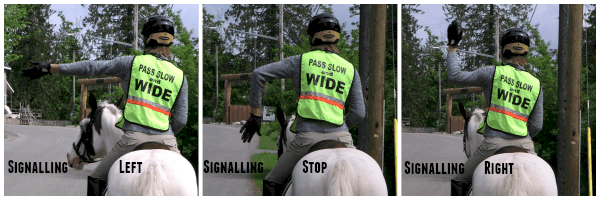HAND SIGNALS
Your horse is considered a vehicle. As a rider, you must therefore follow the basic laws of the road, including yielding, stopping at stop signs, and signalling for turns and stops. The same hand signals used by cyclists are used by equestrians. Hand signals are a means of informing other road users, whether motorists, cyclists, or pedestrians, of the rider’s intent to turn right, left, or stop.

Although motorists with left hand drive vehicles are required to use their left arms to signal, cyclists and equestrians may extend either arm straight from their shoulder and point in the direction of their turn (i.e. point right with right arm outstretched to turn right, and point left with left arm outstretched to turn left). Traditional signals with the left arm are shown below:
Slow down: This signal is that of an open hand (palm out), arm extended, gesturing with a slow pumping action. This signal is often used to advise motorists that they need to slow down when approaching and attempting to pass the horse/rider.
Caution: Don’t overuse the slow down signal. If a motorist is already slowing down, a thank you wave is the best way to encourage and reward their courtesy. Use the slow down signal only if someone is approaching too fast, or if a horse is acting up.
Stop: Arm straight out, open palm extended as if you were pressing against a wall; this gesture is very obvious and is sure to get the attention of the motorist quickly.
Friendly Wave: is a courtesy gesture that generally is and should be extended to motorists when they pass safely, exercising caution; if your hands are not free then a friendly smile or nod is the least a motorist should expect. When motorists are displaying apparent dangerous behaviour and not exercising caution, please refrain from rude gestures or shouting; they are displays of poor etiquette and can lead to an altercation between rider and motorist. Shouting may also startle the horse(s) or cause them to think that they’ve done something wrong. Regardless of the motorist’s actions, please stay calm!
CROSSING THE ROAD SAFELY
Approach the road single file with the most experienced rider/horse in the lead.
STOP
Before crossing the road, get your horse’s focus and full attention before asking it to cross. Be aware of everything going on around you. Wait for a long break in traffic, or for the traffic to be stopped before you cross. However, remember that a horse’s instinct when anxious is to move. It may be necessary for you to let your horse walk in small circles to help it become calm, or to ask it to move its feet a little, forward-back-sideways, to take its mind off what it is anxious about. If you are riding in a group, wait until everyone is ready and then cross as a unit.
LOOK
Look in both directions for oncoming traffic. Check in front to what’s ahead and behind for any potential hazards. Look at the road surface to assess its footing. Mail boxes, flags, or garbage tossed into the ditch could startle your horse. Evaluate what you see to determine if this is a good location for you to cross.
LISTEN
Keep an ear out for approaching cars. Engine sounds give you clues as to what type of vehicles are approaching and the speeds they are traveling. Pay attention to where your horse is listening; they use their ears to focus on sounds and may hear something before you do. Don’t ride in poor light especially without reflective gear.
Step 1 – Signal, and look before turning!
Step 2 – cross, either in single file or abreast, but staying as close together as is safe
Step 3 – maintain safe crossing formation
Step 4 – When crossing complete, riders resume correct formation with one horse length of space between each horse

DO!
DO respect private property and “No Trespassing” signs.
DO leave gates the way you found them: leave them open if they’re open, close them behind you if you have to open them to pass through.
DON’T!
DON’T ride double (two on a horse) or carry something that will affect your balance, or that will interfere with your handling of the reins.
DON’T ride bareback: make sure you have full tack in good condition and that bridles, reins and cinches (or girths) are properly and securely fastened.
DON’T pony another horse from the back of your horse unless you are an experienced rider on an experienced horse.
DON’T ride in a dangerous manner without due care and attention to other road users.
Notice of Holiday Office Closure
The HCBC Office will be closed December 24th and re-opening January 5th
